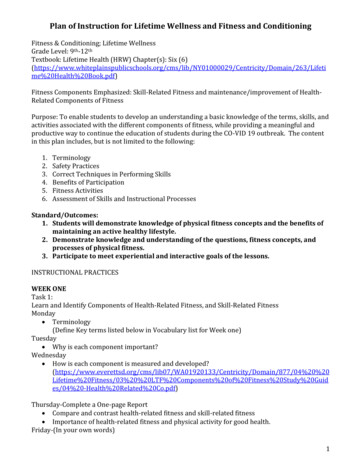
Transcription
Plan of Instruction for Lifetime Wellness and Fitness and ConditioningFitness & Conditioning; Lifetime WellnessGrade Level: 9th-12thTextbook: Lifetime Health (HRW) Chapter(s): Six lth%20Book.pdf)Fitness Components Emphasized: Skill-Related Fitness and maintenance/improvement of HealthRelated Components of FitnessPurpose: To enable students to develop an understanding a basic knowledge of the terms, skills, andactivities associated with the different components of fitness, while providing a meaningful andproductive way to continue the education of students during the CO-VID 19 outbreak. The contentin this plan includes, but is not limited to the following:1.2.3.4.5.6.TerminologySafety PracticesCorrect Techniques in Performing SkillsBenefits of ParticipationFitness ActivitiesAssessment of Skills and Instructional ProcessesStandard/Outcomes:1. Students will demonstrate knowledge of physical fitness concepts and the benefits ofmaintaining an active healthy lifestyle.2. Demonstrate knowledge and understanding of the questions, fitness concepts, andprocesses of physical fitness.3. Participate to meet experiential and interactive goals of the lessons.INSTRUCTIONAL PRACTICESWEEK ONETask 1:Learn and Identify Components of Health-Related Fitness, and Skill-Related FitnessMonday Terminology(Define Key terms listed below in Vocabulary list for Week one)Tuesday Why is each component important?Wednesday How is each component is measured and sday-Complete a One-page Report Compare and contrast health-related fitness and skill-related fitness Importance of health-related fitness and physical activity for good health.Friday-(In your own words)1
Explain how the health-related components of fitness affect a person’s performance whenparticipating in physical activities.WEEK TWOInstructional PracticesIdentify/Define the six components of Skill-Related Fitness and give an example of each: Pleasevideo and submit to teacher via remind, or email.Monday Agility-Please view “Cat & Mouse” https://youtu.be/VTLnC lVu3g Balance-Please view “Balancing, Transferring Weight ”http://www.youtu.be.com/watch?v -DOHpc1DeHI&feature youtu.beTuesday Coordination-Four Square, ”Coordination Activities for Athletes”http://www.youtu.be/JGX2E0 bOoY PowerWednesday Reaction Time-“ Cone Reaction Game" https://youtu.be/2BW8GywwNvY SpeedThursdaySTUDY GUIDES (Quizlet.com)-Health & Skill-related Components of FitnessFriday Online Quiz/Test (TBA by teacher)WEEK THREEIdentify/Define the five components of Health-Related Fitness and give an example of each:(https://www.youtube.com/watch?v AWjxe7k8H3Q&feature youtu.be)Video yourself completing one of each of the following components, using Tic Tok, YouTube, orUpload a video from your phone or computer:Monday Cardiovascular Endurance-Jump rope,(https://www.youtube.com/watch?v AWjxe7k8H3Q&feature youtu.be)Tuesday Muscular Strength- (https://www.youtube.com/watch?v AWjxe7k8H3Q&feature youtu.be)Wednesday Flexibility-“Flexibility Exercises for Teens” html)Thursday Muscular Endurance-( html) Body Composition-“Body Composition” html)Friday Assessment given by teacher via social media platform, or through educational emailAdditional Assessments:2
ple-worksheets#download)WEEK FOURStandard: Evaluate the use of the FITT Principle formula in fitness training.Identify and explain the F.I.T.T principle? FITT. Go over and explain the FITT principle. Frequency (how often you exercise), Intensity (howhard you work during exercise), Time (how long you exercise), Type (type of activity you’re doing).Use sport/life style specific examples.Monday-ThursdayPerform activities related to the four components of the FITT Principle. Record and document thefrequency, intensity, time, and type of activities you choose to do. Try to get a parent or partner tohelp. To insure that you are getting optimal (best) benefits out of your exercise you mustmake sure that you are working at an appropriate intensity. The following measures willallow you to measure your intensity:o The Talk Test During light intensity, you should be able to sing a song, During moderate intensity, you should be able to carry on a conversation During vigorous intensity, you should be winded and have trouble speaking.(Remember: An appropriate intensity is somewhere between the moderate andvigorous level of intensity. You should not be able to carry on a long-windedconversation, but you should be able to communicate with a training partner.) TimeTypeFriday Complete attached packet on FITT Principle for Cardiovascular Fitness. This is due viaupload to email, or Remind, or other technological platform of the teacher’s choice.WEEK FIVEHow do you find your heart rate (check your pulse)? Please use the attached worksheet to completecalculations for each of the following throughout the week. Resting Heart Rate (RHR), Target HeartRate (THR), and your Maximum Heart Rate (MHR). Make sure to submit all assignments by Sundayevening each week.Monday Identify and locate two places where you can check your heart rate (pulse). List the locationof each:o Radialo Carotid Calculate your Resting Heart Rate (RHR)- The RHR should be taken first thing in the morningupon waking up and before getting out of bed.Tuesday Calculate your Target Heart Rate, and Maximum Heart Rates3
WednesdayPerform each activity listed below. Take your heart rate at the end of each activity. Use your carotidor radial artery and count the beat for six (6) seconds. Add zero (0) to the number that you count.ACTIVITYResting Heart RateStandingMedium Paced WalkPush Ups (10); Wall (If needed)Jump Rope, or Jump in PlaceBleacher steps, bench, or step stool (1min.Run In PlaceJoggingAfter Workout Stretching (Cool Down)Your ChoiceHEART RATE4
ThursdayActivity Reflection Questions1. Why is it important to calculate your resting Heart Rate (HR)? How do youTRULY get your resting HR?2. Which activities produced the lowest Heart Rates? Why do you think this isthe case?3. What do you think happens to your RHR over time if you have a regularworkout program? Why?Friday Teacher chosen assessment.WEEK SIX Exercising the Safe Way- Propose ways to reduce or prevent injuries and health problems.Please refer to your textbook online at the link Health%20Book.pdf)Monday Describe six ways to avoid sports injuries, p.139-145.W UEg. Warming up increases blood flow to muscles, stretches yourmuscles and ligaments, and increases your heart rate.C DotreA id De tionAvoidA O eIn5
Tuesday Identify four signs of overtraining. Place the appropriate warning sign in the boxes below.6
Wednesday Describe the R.I.C.E. method of treating minor sports injuries. P.142R.I.C.E.7
Thursday Complete Chapter 6, Section 3 Review-Questions & Answers, 1-9. , p. 145.Friday Chapter 6 Test, HRWo General (without essay)o Advanced (with essay)Chapter 6 Test General.htmChapter 6 Test Advanced2.htmAdditional Resources for FitnessFITNESS FOR LIFE CONCEPT MAP web.htmYOUR PERSONAL FITNESS PROGRAM WEB 1 1J-5J.htmKEY-YOUR PERSONAL FITNESS PROGRAM WEB.htmP4- Fitness testing results recording sheet web.htm1.1 Fitness components and methods of training WEB.htm8
9
10
11
12
Resources:1) RESTING HEART RATE:Use the tips of your first two fingers (not your thumb) to press lightly over the blood vessels onyour wrist or neck. Count your pulse for 15 seconds (use a stopwatch to track the time) andmultiply by 4 to find your one-minute’s worth of a Resting Heart Rate.**If you are having difficulty locating your pulse, put your fingers on the bone located on theinside of your wrist, then move them a finger tip’s length/centimeter toward the midline of yourwrist. This should help you find it. Another option is to use your Carotid Pulse, which is locatedon your neck underneath the point where the side and bottom of your jawbone meet.**The healthy average Resting Heart Rate is anywhere between 60-80 beats per minute.The American Heart Association states that, “Even if you’re not an athlete, knowledge about your heartrate can help you monitor your fitness level — and it might even help you spot developing healthproblems.Your heart rate, or pulse, is the number of times your heart beats per minute. Normal heart rate variesfrom person to person. Knowing yours can be an important heart-health gauge.”RADIAL PULSECAROTID PULSE13
Capstone ProjectPurpose: To provide a way for students to demonstrate the culmination of skills and knowledgegained through their academic careers by completing a long-term, multi-faceted project.Why a Capstone Project?Capstone Projects were developed to encourage student’s ability to think critically, problem-solve,communicate orally, allow students to exhibit research capabilities. Students also learn how toanalyze important issues, problems, and ideas.Requirements: 10-15 pages, not longer than 20 pages.1. Write a clear statement about why you want to be physically active? List your concerns aboutbecoming physically active. Complete Fitness Plan Brainstorming Sheet.Due Week One2. Determine how you will prepare yourself for obstacles. Acknowledge the skills, knowledgeand interests you already have. Identify your social support (parents, friends, relatives,teachers, etc.)Due Week Two3. Determine how you are going to keep yourself motivated; set a start date; and determinehow you will track your progress. Complete the following plan and submit.Due Week Three4. Start thinking about what you might want to adopt in your Fitness Plan. This worksheet isintended to help you visualize your strengths and weaknesses, good and bad habits,motivation strategies, activities that you enjoy as well as general warm-up and cool-downexercises. When designing your Fitness Plan, you will end up using the information on thisworksheet as the substance.Due Weeks 4 & 55. Apply FITT Principles to everyday life.Final Project Due: Week Six14
MY PERSONAL FITNESS PLAN CONTRACT-Due Week OneI, , am going to make acommitment to helping build lifelong fitness and nutrition habits that willaid me in sustaining a long, healthy lifestyle. I will make an attempt tofollow most, if not all, of the guidelines I have designed in my fitness plan.My fitness plan will identify areas where I need improvements in bothfitness and nutrition. I will design realistic, achievable and measurablegoals. My activities will be ones that I can consistently incorporate into mycurrent lifestyle. I will do my very best to keep fitness logs so that I canactually see if I am achieving the guidelines of my fitness plan as well as seeing improvements inmy overall fitness.Benefits of a Fitness PlanIn this section, you are going to list 5 reasons why it is important for YOU to design and follow afitness plan.1.2.3.4.5.Fitness Plan ProjectWhen you complete this project, you will accomplish the following: Setting specific short-term and long-term fitness goals Identify fitness activities that will help you accomplish your goals Determine how often, how hard and how long you will do the activities in a proposedcalendar Track your progress Compare what you planned to what you accomplished and reflect on the processFitness Plan QuestionsA. What are 2 things that you think you can do to make sure you stay motivated to execute yourfitness plan?1.2.B.What are 2 BIG obstacles that you think will stand in your way from consistently followingyour fitness plan?1.2.I understand the conditions of my fitness plan and will do my best to incorporate this plan intomy daily life.Student SignatureDateParent es/ wsb 350x294 inverts working out shrunk.jpg15
FITNESS PLAN BRAINSTORMING SHEETDue Week 1My 2 fitness strengths are:1.2.My 2 fitness weaknesses are:1.2.Challenges/Obstacles To Staying With Plan1.2.3.Strategies To Stay Motivated1.2.3.WARM-UP ACTIVITIES/EXERCISES THAT I ENJOY1.2.3.Flexibility/Stretching Exercises That I Enjoy1.2.3.Muscular Endurance/Strength Exercises That I Enjoy1.2.3.Cardiovascular Exercises That I Enjoy1.2.3.COOL-DOWN ACTIVITIES THAT I ENJOY1.2.16
3.GOAL SETTING SHEETDue Week 2Questions that will help you toward setting goals1. Where do you perform most of your fitness activities?HomeOutsideExplain why?Fitness Facility (gym, health club, pool, etc.)2. What time of day can you do most of your exercise?3. What equipment do you have available on a regular basis? (circle all that apply)NothingFree Weights (dumbbells, etc.)Weight machines Treadmill or other cardio home machinesResistance balls or other core home equipment Resistance BandsExercise Videos Jump RopesBicycle, Skateboards, Roller Blades, other (explain)4. Which of the following are your personal obstacles in adopting a regular fitness program?a) Intimidated and embarrassed when I exercisee) I get bored pretty easily when I exerciseb) I can’t really find the time to exercisef) I have to exercise alonec) I get frustrated because I don’t see results right awayg) My exercise setting does not meet my needsd) Family obligationsh) I do not have personal obstacles, I am lazy5. If you wanted to find out more about how to live a healthier lifestyle, what two types of people do you think you could talk to?a)b)6. What sports or fitness activities do you enjoy participating in and why?7. What type of fitness activities/sports do your parents/guardians participate in?8. Which one of the Fitness Components do you need to improve the most? Why?9. Which one of the Fitness Components do you feel is your strongest? Why?Setting GoalsSetting goals involve following certain criteria:1. Be specific: What is it exactly that you would like to accomplish?2. Be realistic: Do not make goals that are unachievable3. Be flexible: If you say you’ll work out 3 days a week, or for 30 minutes, and something comes up, you can make it upanother day, or add some extra time elsewhere in the workout.4. Measurable: If you are not able to measure your workout, you are unable to measure your progress5. Recognize Obstacles: What is standing in your way of achieving your goals?6. Have short and long-term goals: Stepping stones will let you know if your program is working.7. Write them down: Write down your goals, post them in places where your support system can see.What are your fitness goals? (circle all that apply)AppearanceCardiovascular endurance Reduce body fatGeneral HealthMuscular definitionMuscle sizeSelf-esteem or confidence SpeedSports PerformanceTone and shape my body Lose weightImprove postureGet more flexibleMuscle strengthReduce my stress levelMedical reasonsExample of writing a good cardiovascular goal: I would like to lower my mile time from 8:30 to 8:00 byJune.17
Example of writing a bad cardiovascular goal: I would like to run faster.Example of writing a good muscular strength goal: I would like to increase my pull-up score from 3 to 5 byJune.Example of writing a bad muscular strength goal: I would like to get stronger.Write an example CV goal here:Write an example MS/ME goal here:Write an example Flexibility goal here:18
FITNESS TESTING DATA/PROGRESS CHARTDATEDueWeek 3DATEDATEDATEDAY 1:WEEK 2:WEEK 4:RESTINGHEART RATEBPMBPMBPMBPM1-MILEWALK/JOGMinutes: SecondsMinutes: SecondsMinutes: SecondsMinutes: SecondsWEEK 6:EXERCISEHEART p YSit-and-ReachBODYCOMPOSITIONMeasurements**See chart fordescription ofexact :Hips:RightLeg:RightLeg:RightLeg:RightLeg:Left Leg:Left Leg:Left Leg:Left Leg:Weight:Weight:Weight:Weight:19
PART 2: PERSONAL FITNESS GOALSDue Week 4Each Fitness test you completed focuses on one of the 5 given areas of Health-RelatedFitness to give you a holistic idea of your current state of fitness. With your test resultsin mind, use the given Goals Worksheet to create SPECIFIC and MEASURABLE goalsfor each category that reflect on the given fitness test results. Ask yourself, “What are mygoals (# of push-ups, weight, time for the mile run, and etcetera)?”Cardiovascular EnduranceThe ability to exercise the entire body for long periods of time. It requires a strong heart,healthy lungs, and clear blood vessels to supply the body with oxygen. Activities toimprove fitness in this area include running, swimming and aerobic dance. A personshould do the activity continuously for a minimum of 20 minutes within their target heartrate zone. Endurance/cardiovascular activity should be done a minimum of 3 days perweek. Every other day is preferable. The mile or the pacer will measure fitness testing inthis area.Muscular StrengthThe amount of force you can exert with your muscles. It is often measured by how muchweight you can lift. People with strength have fewer problems with backaches and cancarry out their daily tasks efficiently. Examples of muscular strength include: push-ups,lifting heavy weights with few repetitions, and pull-ups. Fitness testing is measured bydoing push-ups.Muscular EnduranceThe ability to use the muscles, which are attached to the bones, many times withoutgetting tired. People with good muscular endurance are likely to have better posture, havefewer back problems, and resist fatigue better than people who lack muscular endurance.You can improve muscular endurance by lifting weights with many repetitions or doingsit-ups. Measuring the number of sit-ups done correctly is used for fitness testing.FlexibilityThe ability to use your joints fully. You are flexible when the muscles are long enoughand the joints are free enough to allow movement. People with good flexibility havefewer sore and injured muscles. Stretching before and after activities will help to improveflexibility. The sit-and-reach and the trunk lift are two tests used to measure flexibility.Body CompositionThe percentage (ratio) of body weight that is fat in comparison to other body tissue, suchas bone and muscle. People who have a high percentage of fat are more likely to be illand have a higher death rate than lean people. Exercise and eating the right foods in theproper amounts can improve body composition. Body composition can be measuredusing an instrument called calipers, a specialized scale, or by calculating the body massindex (BMI) which uses height and weight to determine your BMI.20
FITNESS TESTING GOALSDue Week 5What state of Fitness do you want to have? What are you working toward?RESTINGHEART RATEBPM1-MILEWALK/JOGMinutes: SecondsEXERCISE HEART RATEBPMMUSCULAR STRENGTH ANDENDURANCEPush-Up hest:BODY COMPOSITIONMeasurements**See chart for description of exact bodylocations!Right Arm:Left Arm:Stomach:Hips:Right Leg:Left Leg:Weight:21
CARDIOVASCULARACTIVITY EXPANSIONApplying the FITT PRINCIPLESChoose ONE activity from the Cardiovascular category on your Fitness PlanBrainstorming Sheet. You need to explain how you will specifically warm-up, cool-down,progress from week 1 to week 2, and what obstacles might be in your way for each of the activities.Use the cardio example below to help you.CARDIOVASCULAR SHORT TERM GOAL:CARDIOVASCULAR LONG TERM GOAL:CARDIO ACTIVITY:WARM-UP: (How are you preparing your body for this workout?)The exercise(s) that I’m doing to warm-up is:The specific muscle(s) that I will target during this workout are:Week 1 F.I.T.Frequency days/weekHow often (days/week) are you going to do thisactivity?Intensity - BPM How hard? What HR range will your workout be in?Time min How long? What is the total time of your workout includingwarm-up & cool-down?**PROGRESSION- WEEK 2 NEEDS TO BE MORE CHALLENGING THAN WEEK 1 BYADJUSTING ANY COMBINATION OF THE FREQUENCY, INTENSITY OR TIME.Week 2 F.I.T.Frequency days/week How often (days/week) are you going to do this activity?Intensity - BPM How hard? What HR range will your workout be in?Time min How long? What is the total time of your workout including warm-up &cool-down?COOL-DOWN: (how are you preparing your body to recover from this workout?)OBSTACLES: (what two variables are hindering you from completing your F.I.T. goals?)22
MUSCULAR STRENGTH/ENDURANCEACTIVITY EXPANSIONApplying the FITT PRINCIPLESChoose ONE activity from the Muscular Strength/Endurance category on your Fitness PlanBrainstorming Sheet. You need to explain how you will specifically warm-up, cool-down, progress fromweek 1 to week 2, and what obstacles might be in your way for each of the activities. Use the cardio examplebelow to help you.MS/ME SHORT TERMGOAL:MS/ME LONG TERM GOAL:MS/ME ACTIVITY #1:WARM-UP: (How are you preparing your body for this workout?)The exercise(s) that I’m doing to warm-up is:The specific muscle(s) that I will target during this workout are:Week 1 F.I.T.Frequency days/week How often (days/week) are you going to do this activity?Intensity RPE How hard? What is the RPE (1-10 Scale) for this exercise?Sets Repetitions:Weight:Time min How long? What is the total time of your workout including warm-up &cool-down?***PROGRESSION- WEEK 2 NEEDS TO BE MORE CHALLENGING THAN WEEK 1BY ADJUSTING ANY COMBINATION OF THE FREQUENCY, INTENSITY OR TIME.Week 2 F.I.T.Frequency days/week How often (days/week) are you going to do this activity?Intensity RPE How hard? What is the RPE (1-10 Scale) for this exercise?Sets Repetitions:Weight:Time min How long? What is the total time of your workout including warm-up &cool-down?COOL-DOWN: (how are you preparing your body to recover from this workout?)OBSTACLES: (what two variables are hindering you from completing your F.I.T. goals?)23
EXAMPLE GOALSEXAMPLE CARDIOVASCULAR SHORT TERM GOAL: To be able to run a mile in 7:45 byJune.EXAMPLE CARDIOVASCULAR LONG TERM GOAL: To be able to run a mile in under7:20 by September.EXAMPLE CARDIO ACTIVITY : Running/JoggingWARM-UP: (How are you preparing your body for this workout?)The exercise(s) that I’m doing to warm-up is: Stretching, lower body and upper bodystretchesThe specific muscle(s) that I will target during this workout are: quadriceps,hamstrings, calves, pectorals, abdominalsWeek 1 F.I.T.Frequency 3 days/weekHow often (days/week) are you going to do thisactivity?Intensity 125 - 150 BPM How hard? What HR range will your workout be in?Time 25 min How long? What is the total time of your workout including warm-up &cool-down?Week 2 F.I.T.Frequency 3 days/week How often (days/week) are you going to do this activity?Intensity 130 - 160 BPM How hard? What HR range will your workout be in?Time 30 min How long? What is the total time of your workout including warm-up &cool-down?COOL-DOWN: I am going to walk for 5 minutes to lower my HR to under 100 bpm,and I’m going to do some light lower body stretches focusedOBSTACLES: Weather, motivation, partner’s scheduleEXAMPLE MS/ME SHORT TERM GOAL: To be able to do 5 pull-ups by June.EXAMPLE MS/ME LONG TERM GOAL: To be able to do 8 pull-ups by 9th GradeFitnessgram testEXAMPLE MS/ME ACTIVITY : Pull-UpsWARM-UP: (How are you preparing your body for this workout?)The exercise(s) that I’m doing to warm-up is: Stretching upper bodyThe specific muscle(s) that I will target during this workout are: pectorals, abdominals,biceps, triceps, lats.Week 1 F.I.T.Frequency 3 days/week How often (days/week) are you going to do this activity?Intensity 6 RPE How hard? What is the RPE (1-10 Scale) for this exercise?Sets 3Repetitions: 15Weight: 15 lbs.Time 15 min How long? What is the total time of your workout including warm-up &cool-down?Week 2 F.I.T.Frequency 3 days/week How often (days/week) are you going to do this activity?Intensity 7 RPE How hard? What is the RPE (1-10 Scale) for this exercise?Sets 3Repetitions: 18Weight: 18 lbs.Time 15 min How long? What is the total time of your workout including warm-up &cool-down?COOL-DOWN: I am going to focus on upper body stretches, walk on treadmill for 5 minutes.OBSTACLES: Access to gym, homework24
PART 3: PERSONAL FITNESS PLANCompleted Week 6Before you begin your Fitness Plan outline, make sure you know and understandthe following information:Warm up (at least 5 minutes BEFORE any activity)Before you exercise, think about warming up your muscles like you would warm up yourcar. It increases the temperature and flexibility of your muscles, and helps them be moreefficient and safer during your workout. A warm-up before allows a gradual increase inheart rate and breathing at the start of the activity.Cool down (5 minutes AFTER any activity)Cooling down after a workout is as important as warming up. After physical activity,your heart is still beating faster than normal, your body temperature is higher and yourblood vessels are dilated. This means if you stop too fast, you could pass out or feel sick.A cool-down after physical activity allows a gradual decrease in heart rate at the end ofthe episode.**NEVER STRETCH YOUR MUSCLES BEFORE YOU WARM YOUR BODYUP! It can actually DECREASE your performance ability and cause INJURY! Agreat time to stretch would be after your given Warm-Up routine or during theconclusion of your workout and/or Cool-Down.25
ty/FitnessBasics/Warm-UpCool-Down UCM 430168 tRates UCM 434341 sicaleducation.com/AddResources/2 Week Fitness Plan files/FitnessPlanFullPacketv2.1.docCOPYRIGHTThis Personalized Fitness Plan is protected by copyright laws and is the copyrightof Tara Sill. The document may not be copied, reproduced, republished,uploaded, posted, broadcast or transmitted in any way. All intellectual propertyrights in relation to this Fitness Plan are reserved and owned by Tara Sill.Modification of any of the materials or use of the materials for any other purposewill be a violation of copyright laws and other intellectual property rights.Additional Resources Skill-related fitness (http://www.youtu.be/jK725luW9hA)Health-related fitness (http://youtu.be/eCJovVdQgVw)FITT Principle (http://youtu.be/ReS YFAUz5k)ACSM.comAppso Make Me Fabulouso Activities for Youo Sense Me26
o 30-Day Fitness ion/attachments/std pe gr obehealthy.orgwww.mbsfitness.com27
1 Plan of Instruction for Lifetime Wellness and Fitness and Conditioning Fitness & Conditioning; Lifetime Wellness Grade Level: 9th-12th Textbook:










